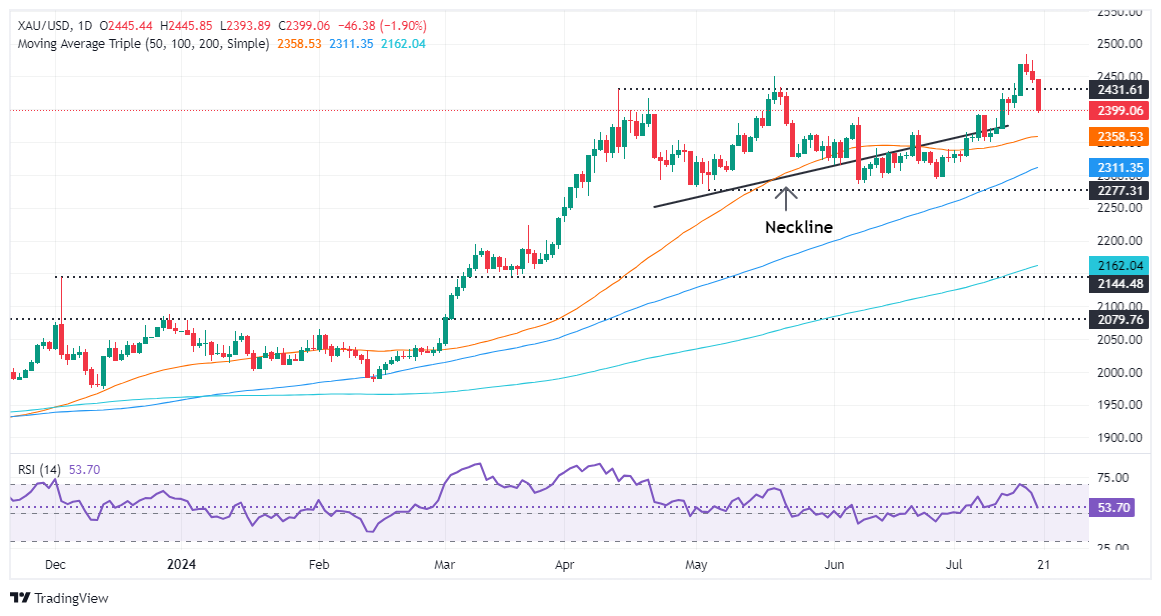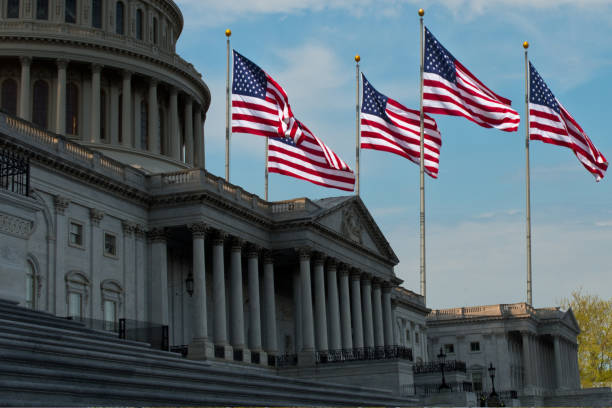- Gold drops to $2,399, down 1.50%, after hitting a high of $2,447.
- Concerns over China's economic growth and Trump's election prospects boost the Greenback.
- US Dollar Index rises to 104.34, up 0.18%; US Treasury yields climb, with 10-year note at 4.233%.
Gold price sinks by more than 1.50% on Friday and hovers around $2,400 as traders book profits ahead of the weekend. The golden metal could finish the week with losses close to 1% after hitting an all-time high of $2,483 and trading at around the $2,300 handle. The XAU/USD exchanges hands at $2,399 after reaching a high of $2,447.
Trader sentiment is gyrating due to several factors. China’s economy is growing less than expected, and an increasing rumble that former President Donald Trump might win the November 5 elections boosted the Greenback, which is set to end the week with gains of more than 0.26%, according to the US Dollar Index (DXY).
Besides that, reports emerged that US President Joe Biden could pull out of the race as high-level democrats said polls following Trump’s assassination attack show that he can’t beat him.
In the meantime, Federal Reserve policymakers continued to turn slightly dovish yet failed to undermine the US Dollar. Nevertheless, the International Monetary Fund (IMF) said on Thursday that the Fed should not cut interest rates until late 2024.
The US Dollar Index, which tracks the currency's performance against six other currencies, is up 0.18% at 104.34. US Treasury bond yields are also rising across the yield curve, with the 10-year Treasury note yielding 4.233%, up more than three basis points (bps).
Daily digest market movers: Gold price tanks below $2,400
- Weaker-than-expected US Consumer Price Index (CPI) data boosted Gold prices above $2,400, as the increased likelihood of Fed rate cuts led to falling US Treasury bond yields.
- This week’s data featured mixed Retail Sales reading, a slowdown in Industrial Production, and the increase of Americans filling for unemployment benefits, reinforcing the Fed’s rhetoric that its dual mandate has become more balanced.
- December 2024 fed funds rate futures contract implies that the Fed will ease policy by 50 basis points (bps) toward the end of the year, up from 50 last Friday.
- Investors will focus on speeches from Fed policymakers: New York Fed President John Williams and Atlanta Fed President Raphael Bostic are scheduled to speak during the New York session.
Gold technical analysis: XAU/USD tumbles beneath $2,400 as buyers stay on the sidelines
Gold prices are experiencing a pullback, signaling that traders continued to take profits after an 8% rally experienced since June 27. Although the Relative Strength Index (RSI) remains bullish, in the near-term momentum favors sellers. The RSI has experienced a vertical fall, though shy of piercing the 50-neutral line.
Therefore, XAU/USD first support would be the July 5 high at $2,392, followed by the psychological 50-day Simple Moving Average (SMA) at $2,357. The next support would be $2,350, followed by the 100-day SMA at $2,312
Otherwise, if XAU/USD stays above $2,400 and reclaims $2,450, that can pave the way to challenge the all-time high of $2,483 ahead of hitting $2,500.

Fed FAQs
Monetary policy in the US is shaped by the Federal Reserve (Fed). The Fed has two mandates: to achieve price stability and foster full employment. Its primary tool to achieve these goals is by adjusting interest rates. When prices are rising too quickly and inflation is above the Fed’s 2% target, it raises interest rates, increasing borrowing costs throughout the economy. This results in a stronger US Dollar (USD) as it makes the US a more attractive place for international investors to park their money. When inflation falls below 2% or the Unemployment Rate is too high, the Fed may lower interest rates to encourage borrowing, which weighs on the Greenback.
The Federal Reserve (Fed) holds eight policy meetings a year, where the Federal Open Market Committee (FOMC) assesses economic conditions and makes monetary policy decisions. The FOMC is attended by twelve Fed officials – the seven members of the Board of Governors, the president of the Federal Reserve Bank of New York, and four of the remaining eleven regional Reserve Bank presidents, who serve one-year terms on a rotating basis.
In extreme situations, the Federal Reserve may resort to a policy named Quantitative Easing (QE). QE is the process by which the Fed substantially increases the flow of credit in a stuck financial system. It is a non-standard policy measure used during crises or when inflation is extremely low. It was the Fed’s weapon of choice during the Great Financial Crisis in 2008. It involves the Fed printing more Dollars and using them to buy high grade bonds from financial institutions. QE usually weakens the US Dollar.
Quantitative tightening (QT) is the reverse process of QE, whereby the Federal Reserve stops buying bonds from financial institutions and does not reinvest the principal from the bonds it holds maturing, to purchase new bonds. It is usually positive for the value of the US Dollar.








